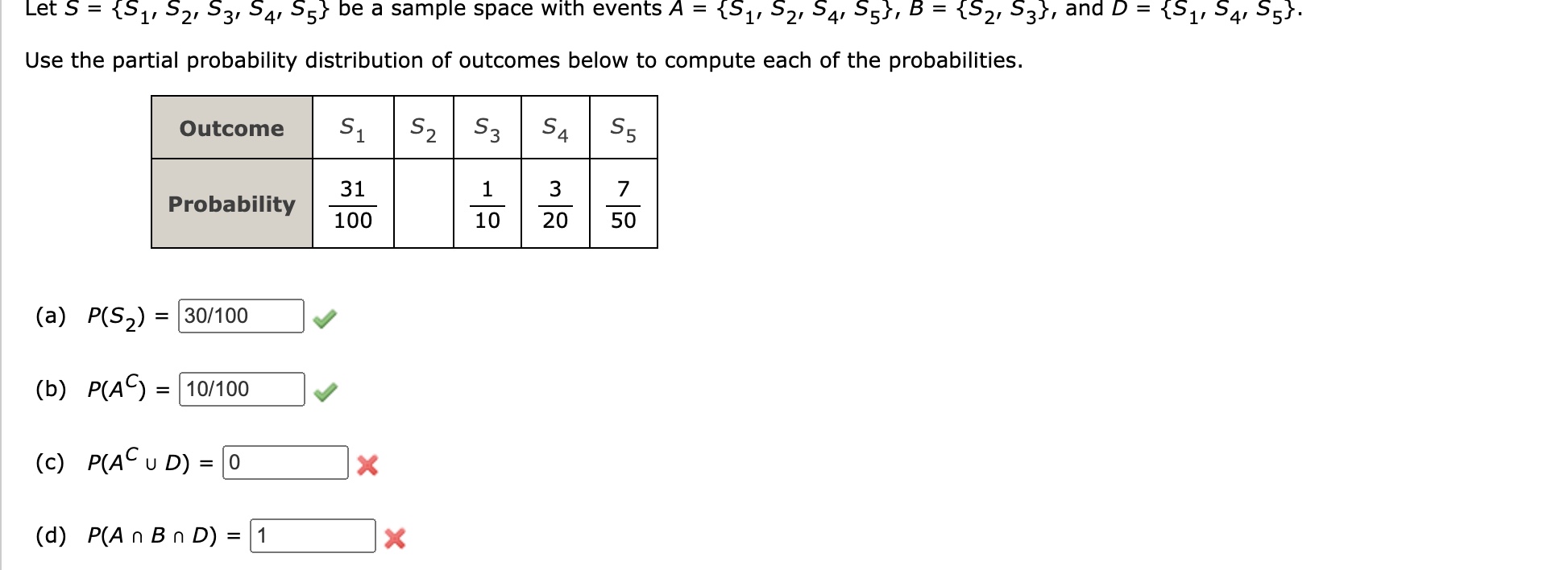Let S = {S1, S2, S3, S4, S5} be a sample space with events A = {S1, S2, S4, S5}, B = {S2, S3}, and D = {S1, S4, S5}. Use the partial probability distribution of outcomes to compute... Let S = {S1, S2, S3, S4, S5} be a sample space with events A = {S1, S2, S4, S5}, B = {S2, S3}, and D = {S1, S4, S5}. Use the partial probability distribution of outcomes to compute each of the probabilities: (a) P(S2) = ? (b) P(Ac) = ? (c) P(Ac ∪ D) = ? (d) P(A ∩ B ∩ D) = ?

Understand the Problem
The question provides a sample space S and several events (A, B, D) defined as subsets of S. It also gives a probability distribution for each outcome in S. The task is to compute the probabilities of various events based on the given information. Specifically, it requires calculating the probability of outcome S2, the complement of event A, the union of the complement of A and D, and the intersection of A, B, and D.
Answer
(a) $P(S_2) = \frac{10}{100}$ (b) $P(A^c) = \frac{15}{100}$ (c) $P(A^c \cup D) = \frac{74}{100}$ (d) $P(A \cap B \cap D) = 0$
Answer for screen readers
(a) $P(S_2) = \frac{10}{100}$ (b) $P(A^c) = \frac{15}{100}$ (c) $P(A^c \cup D) = \frac{74}{100}$ (d) $P(A \cap B \cap D) = 0$
Steps to Solve
- Find $P(S_2)$
From the table, the probability of $S_2$ is $\frac{1}{10}$. Convert this to a fraction with a denominator of 100. $$\frac{1}{10} = \frac{1 \times 10}{10 \times 10} = \frac{10}{100}$$
- Find $P(A^c)$
$A^c$ is the complement of $A$, which means it includes all outcomes in $S$ that are not in $A$. Since $A = {S_1, S_2, S_4, S_5}$, then $A^c = {S_3}$. So, we need to find $P(S_3)$. From the table, $P(S_3) = \frac{3}{20}$. Convert this to a fraction with a denominator of 100. $$\frac{3}{20} = \frac{3 \times 5}{20 \times 5} = \frac{15}{100}$$
- Find $P(A^c \cup D)$
$A^c = {S_3}$ and $D = {S_1, S_4, S_5}$. The union of these two sets $A^c \cup D = {S_1, S_3, S_4, S_5}$. So, $P(A^c \cup D) = P(S_1) + P(S_3) + P(S_4) + P(S_5)$. $P(S_1) = \frac{31}{100}$, $P(S_3) = \frac{3}{20} = \frac{15}{100}$, $P(S_4) = \frac{7}{50} = \frac{14}{100}$, and $P(S_5) = \frac{7}{50} = \frac{14}{100}$. Therefore, $P(A^c \cup D) = \frac{31}{100} + \frac{15}{100} + \frac{14}{100} + \frac{14}{100} = \frac{31+15+14+14}{100} = \frac{74}{100}$.
- Find $P(A \cap B \cap D)$
$A = {S_1, S_2, S_4, S_5}$, $B = {S_2, S_3}$, and $D = {S_1, S_4, S_5}$. $A \cap B \cap D$ means the intersection of all three sets, i.e., the elements that are present in all three sets. The only element in all three sets is $S_2$ is not in $D$, $S_3$ is not in $A$ or $D$, $S_1$ is not in $B$, $S_4$ is not in $B$, and $S_5$ is not in $B$. Therefore, $A \cap B \cap D = \emptyset$, which means $P(A \cap B \cap D) = 0$.
(a) $P(S_2) = \frac{10}{100}$ (b) $P(A^c) = \frac{15}{100}$ (c) $P(A^c \cup D) = \frac{74}{100}$ (d) $P(A \cap B \cap D) = 0$
More Information
The problems involve understanding basic probability concepts such as the probability of an event, complementary events, union of events, and intersection of events. The key is to correctly identify the elements in each set and then use the given probability distribution to compute the required probabilities.
Tips
- Incorrectly calculating the probability of an event by not considering all the outcomes in the event.
- Making errors in set operations (union, intersection, complement).
- Failing to convert probabilities to a common denominator before adding them.
AI-generated content may contain errors. Please verify critical information